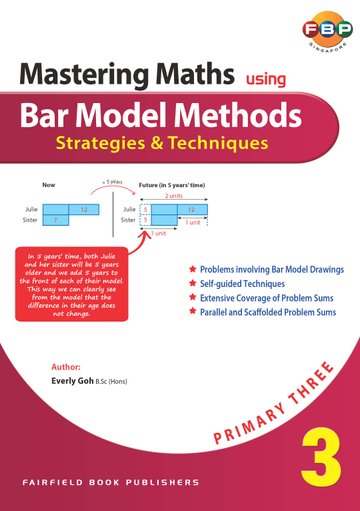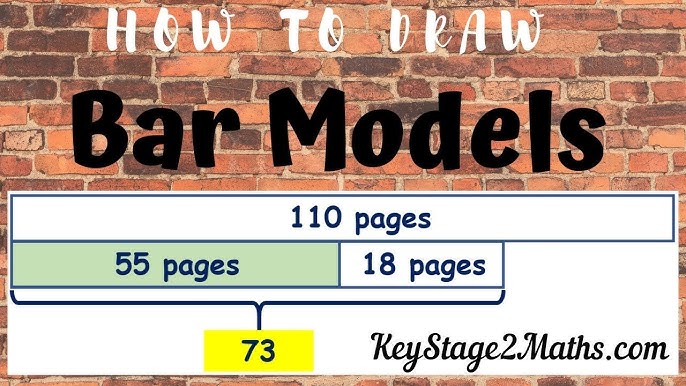A simple guide to understanding math better through bar model drawing techniques
Wiki Article
Exploring Bar Design Illustration Techniques: A Comprehensive Guide to Envisioning Mathematics Concepts
Bar model drawing methods work as a beneficial resource for both teachers and trainees in visualizing mathematical ideas. These versions streamline complex mathematical partnerships, assisting in the comprehension of addition, reduction, reproduction, and department. This overview outlines reliable techniques for carrying out bar versions, promoting energetic engagement and real-world connections. As readers check out the useful applications and mentor pointers, they will discover exactly how these methods can change their approach to maths.Recognizing the Essentials of Bar Version Illustration
Bar version attracting acts as an effective aesthetic device in maths, facilitating the understanding of analytic techniques and numerical relationships. This technique involves representing numbers and their relationships through rectangle-shaped bars, making it simpler to envision procedures such as enhancement, subtraction, reproduction, and division. Each bar's length represents a details value, allowing learners to contrast quantities and recognize percentages clearly.To create a bar model, one begins by determining the trouble's crucial aspects, often simplifying right into parts that can be visually represented. In an easy addition issue, two bars can be drawn, with their sizes standing for the addends. The combined size highlights the sum. Additionally, bar designs can be adapted for much more intricate issues, including fractions and proportions, by readjusting the bars as necessary. Mastering these basics lays a solid foundation for reliable analytic and much deeper mathematical comprehension.
Advantages of Making Use Of Bar Versions in Mathematics
Using bar models in maths uses numerous benefits that boost understanding and comprehension. These graphes help students in realizing intricate concepts by damaging them down into convenient components. Bar versions offer a clear structure for illustrating partnerships between numbers, making abstract concepts extra concrete. They promote a much deeper understanding of mathematical operations and assist in analytic by permitting learners to picture the information they are working with.Moreover, bar models support the advancement of essential believing abilities, as pupils have to analyze and analyze the aesthetic information to reason. This technique motivates energetic involvement with the product, enhancing retention and proficiency of mathematical principles. By promoting a strong foundation in visual proficiency, bar models empower students to approach numerous mathematical challenges with confidence. In general, the combination of bar models into mathematics education verifies beneficial in growing both understanding and logical capabilities among students.
Applying Bar Models to Addition and Subtraction
Bar versions function as an efficient tool for visually standing for enhancement and subtraction problems. By illustrating the partnership between numbers, they improve understanding and help with problem-solving. Additionally, real-life applications of these designs can help students comprehend mathematical ideas in useful contexts.Standing For Addition Visually
When students run into addition and subtraction problems, aesthetic aids can greatly boost their understanding of these operations. Bar designs act as efficient tools for standing for addition. By splitting a rectangle right into segments that correspond to the numbers involved, trainees can visualize the connection in between the quantities. As an example, if a student requires to include 3 and 5, they can produce a bar separated into 2 areas: one area representing 3 and the other representing 5. This clear depiction not only simplifies the enhancement procedure yet likewise enhances the concept of integrating quantities. As pupils manipulate these visual help, they establish a much deeper understanding of enhancement, causing improved analytical abilities and better confidence in their mathematical capabilities.
Reduction With Bar Designs
Although reduction is commonly regarded as an extra intricate procedure than addition, bar models can effectively clarify this procedure for trainees. By aesthetically standing for the amounts involved, trainees can better comprehend just how numbers relate to one another. In a bar model for subtraction, one bar represents the overall, while one more indicates the quantity being subtracted. This visual difference aids pupils grasp the concept of "eliminating." As an example, if a bar reveals 10 units, and an additional bar standing for 4 systems is gotten rid of, pupils can quickly see that 6 systems stay. This technique not just cultivates understanding of reduction however also help in establishing analytical skills, allowing pupils to envision their mathematical thinking and boost their general comprehension of mathematical principles.Real-Life Application Instances
Recognizing subtraction through bar models lays a foundation for using these methods in real-life circumstances. In different contexts, such as budgeting or shopping, people can imagine exactly how much money continues to be after expenses. For instance, if a person has $50 and spends $20, a bar version can stand for the overall quantity and the spent part, showing that $30 is left. In addition, moms and dads can make use of bar designs to assist children understand the number of even more products require to be contributed to finish a set, such as having three apples and needing 5. This graph simplifies intricate problems, promoting understanding and retention. Ultimately, bar designs act as efficient tools in daily decision-making, improving mathematical understanding in functional situations.Imagining Reproduction and Division With Bar Designs
In exploring the application of bar models for reproduction and division, it is necessary to grasp their foundational principles. Constructing multiplication designs allows learners to picture partnerships in between numbers, while effective division techniques can be shown with these aesthetic help. This strategy boosts comprehension and problem-solving skills in mathematics.Comprehending Bar Designs
Bar versions offer as an effective visual device for showing the ideas of reproduction and department. They enable learners to represent mathematical connections in an organized style, promoting a deeper understanding of these procedures. In multiplication, bar designs present groups of equivalent dimension, enabling individuals to envision the complete quantity when integrating these groups. Alternatively, in department, bar versions assist portray how a total is divided into smaller, equal parts, making clear the principle of dividing. By using these visual aids, pupils can realize the underlying concepts of reproduction and division a lot more successfully. This technique not only enhances comprehension yet likewise supports analytic abilities, making bar designs a very useful property in mathematical education.Creating Reproduction Designs
Building reproduction versions using bar diagrams uses a clear technique for imagining the process of reproduction. These company website designs allow learners to stand for multiplication as teams of equivalent parts, making abstract principles much more concrete. For example, to highlight (3 times 4), a trainee check out here can draw one bar divided into 3 equal sections, each representing 4 units. In addition, producing a 2nd bar with the same length reinforces the understanding of duplicated addition, as each section represents one team. This visual representation not just help in realizing multiplication however additionally enhances analytical abilities. By utilizing bar designs, trainees can much better comprehend relationships in between numbers and establish a durable foundation for extra intricate mathematical concepts, leading to raised confidence in their capabilities.Picturing Division Approaches

Solving Word Issues Using Bar Version Techniques

As an example, in an issue involving addition and reduction, trainees can draw separate bars for each and every amount and after that adjust them to discover the service. This process not just makes clear the problem however also cultivates a much deeper conceptual understanding. Bar designs can be adapted for numerous types of word troubles, making them versatile across various mathematical topics. Inevitably, using bar models can greatly enhance students' problem-solving abilities by offering a clear aesthetic path to reach the correct response.
Integrating Bar Designs in Different Math Topics
Bar versions can be flawlessly incorporated into numerous math subjects, enhancing pupils' understanding of ideas past basic math. In algebra, these visual devices help in representing equations and inequalities, allowing students to visualize partnerships between variables. When taking on geometry, bar models can show the properties of forms and spatial reasoning, assisting pupils grasp ideas like area and border effectively. In stats, bar models promote the interpretation of data sets, allowing students to compare quantities and acknowledge patterns aesthetically. Additionally, integrating bar designs within dimension topics aids in comprehending devices and conversions by providing a concrete depiction of amounts. By employing bar models across different mathematical areas, instructors can cultivate a deeper comprehension of complicated ideas, consequently boosting analytical skills and promoting important reasoning (bar model drawing techniques). This versatility shows the utility of bar models as a foundational tool for students in their mathematical tripTips for Mentor Bar Designs Successfully
Incorporating bar designs into teaching practices calls for thoughtful methods to optimize their performance. Educators needs to start by presenting bar models advice with simple, relatable examples that pupils can easily understand. This assists to build self-confidence and knowledge with the principle. Gradually raising the intricacy of issues enables students to apply their skills considerably. In addition, teachers need to motivate trainees to develop their very own bar versions, promoting active involvement and ownership of their knowing.Including collaborative activities can likewise enhance understanding, as trainees discuss and resolve troubles in teams. Continuous responses is important; educators should supply useful commentary on trainees' bar version representations to assist enhancement. Lastly, linking bar designs to real-life circumstances reinforces their importance, aiding trainees see the practical applications of their mathematical abilities. By executing these techniques, teachers can successfully harness the power of bar versions in their maths guideline.
Regularly Asked Concerns
Can Disallow Versions Be Made Use Of in Other Subjects Besides Mathematics?
Bar designs can certainly be utilized in different topics past mathematics. They effectively show principles in scientific research, social studies, and language arts, aiding to visually stand for connections, processes, and concepts for boosted understanding throughout self-controls.What Age Group Is Ideal Suited for Learning Bar Models?
Bar versions are best suited for youngsters ages 7 to 12, as they develop concrete thinking abilities throughout this duration (bar model drawing techniques). At this age, pupils can efficiently grasp abstract concepts with graph and analytical methodsAre There Digital Tools for Creating Bar Models?

Exactly How Can I Evaluate Pupil Comprehending of Bar Versions?
Examining pupil understanding of bar versions can include quizzes, observational evaluations, and seminar. Educators may additionally evaluate pupils' finished models and their capability to explain their reasoning, making sure an extensive examination of comprehension.What Prevail Mistakes When Making Use Of Bar Models?
Common mistakes when utilizing bar models include misstating quantities, falling short to properly identify bars, perplexing addition and subtraction, neglecting to use constant ranges, and neglecting the importance of clear visual splitting up between various components.In enhancement, bar versions can be adjusted for extra complex issues, including fractions and proportions, by changing the bars as necessary. Reduction is usually viewed as a more complex procedure than addition, bar models can successfully clarify this procedure for students. In a bar design for reduction, one bar stands for the total amount, while one more shows the amount being subtracted. If a bar shows 10 systems, and another bar representing 4 systems is removed, pupils can easily see that 6 units continue to be. When separating a total right into equivalent teams, students can attract a lengthy bar to represent the entire and then segment it right into smaller sized bars that show each group.
Report this wiki page